Alaska Ballot Measure 2, one of two citizens’ initiatives on the ballot this November, could revolutionize the election process for Alaskan voters. Some feel that is a good thing while others feel it would do more harm than good. KNOM spoke with the Alaskans for Better Elections’ “Vote Yes on 2” campaign about this ballot initiative.
Campaign manager and spokesperson Shea Siegert gave a brief rundown about how Ballot Measure 2 will improve Alaska’s elections, if approved.
“What Ballot Measure 2 does is it gives more voice, choice, and power back to Alaska voters, and it does this in three ways.”
– Shea Siegert
The three components encompassed in Ballot Measure 2 are increased campaign financing disclosure requirements, a top-four primary election open to all Alaskan voters, and ranked choice voting in the general election.
If Ballot Measure 2 is approved, all three of these changes to Alaskan elections would be implemented, marking a radical shift from the current system. Only 22 municipalities and one state currently have ranked choice voting, and Alaska would be the first state to have an open primary coupled with ranked choice voting (RCV).
Siegert believes this shift is necessary and will benefit all Alaskans.
“When you implement ranked choice voting and open primaries together, you get an elected population that looks more like the population electing them, and so you have a more representative government.”
– Shea Siegert
Both the advocates and opponents of Ballot Measure 2 consider their campaigns to be “nonpartisan” and aimed at amplifying the voices of Alaskan voters.
Defend Alaska Elections, the “Vote No on 2” campaign, has received donations from mostly conservative organizations; however, the campaign has also garnered support from top Democrats in the state like former U.S. Senator for Alaska Mark Begich.
The Defend Alaska Elections campaign claims that Ballot Measure 2 amounts to “political trickery” that is being funded by out-of-state billionaires as a kind of political experiment. In addition, Defend Alaska Elections claims that the 25 page-long initiative is “confusing” and Alaskan voters will be disenfranchised as a result.
Siegert disagrees with that assertion.
“I get kind of offended when they say that because I look out at fellow Alaskans here in Anchorage and across the state… I’ve worked in Kotzebue, Haines, Kenai, Anchorage; and I look at Alaskans, and I don’t think counting to four is too confusing for anyone.”
– Shea Siegert
At the general election, voters would utilize RCV by ranking the top four candidates that advanced past the open primary. In order to win, a candidate would need a simple majority of the vote (50%+1).
If no candidate wins the majority, the candidate with the least number of votes would be eliminated, and the people who chose that candidate as their first choice would have their votes redistributed to their second choice. This process would continue until there are only two candidates remaining, and the candidate with the most votes would be the winner.
Despite the fact that ranked choice voting only exists in Maine, Joy Huntington, a member of the Alaska Natives for Better Elections coalition, says the proof of RCV’s ability to elect a more representative government is in the pudding.
“So a 2016 study from the University of Missouri at St. Louis, indicated that ranked choice voting increases voter turnout by about 10%, and also, we see the minority vote coming out a lot stronger on Election Day. Also, more people of color are actually running for office, and they are more likely to win with ranked choice voting.”
– Joy Huntington
The Defend Alaska Elections “Vote No on 2” campaign contends that, if passed, this initiative will create an environment where candidates are afraid to be controversial.
However, the Alaskans for Better Elections campaign sees this shift as indicative of greater cooperation and an incentive for politicians to work together.
“There’s been 22 cities across the nation that have implemented it and one state. What we find is that their voters aren’t confused, they’re more satisfied with the outcomes because more of the district supports the candidate that is getting elected. What you also find are campaigns start to be based on issues rather than partisan slogans or based on mudslinging.”
– Shea Siegert
Ballot Measure 2 has been endorsed by the League of Women Voters of Alaska, Action Now Initiative, Democracy for America, FairVote Action Fund, Represent.Us, Unite America, and American Promise.
All Alaskan voters will have the final say on whether or not Ballot Measure 2 passes during the general election on November 3rd.
Image at top: Nome’s polling place with voting booths filled by Alaskan voters. Photo from David Dodman, KNOM.





